|
New
Jersey Commission on Higher Education
Executive
Director’s Report
October 29, 2004

|
|

In September, the National Center for
Public Policy and Higher Education issued its third biennial
national report card for higher education. Measuring
Up 2004 is intended to provide the public
and policymakers with information to assess and improve
higher education in each state. The report card grades states in five areas, and gives
all states an incomplete in learning outcomes, because
there is currently no comparable information across states. Overall, Measuring Up has provided useful information
since it began in 2000, including an important comparative
context for states. A new feature of the report this
year provides trend data over a decade, and the long-term
look raises some cause for concern. As with any report,
what’s included and not included in the data raises methodology
questions. And the findings sometimes don’t reflect
important particulars about each state. Nonetheless,
this year’s report brings important issues to center
stage.
|
|

In four performance measures, grades are calculated
by comparing each state’s current performance to that
of the best-performing states. The affordability measure
is calculated differently, for the first time this year – it
compares each state’s current results to the performance
of the top states a decade ago. This change has raised
some concerns, and the methodology for calculating federal
aid has been questioned, suggesting that it significantly
exaggerates the findings in this area. But whether exaggerated
or not, the issue of affordability is a serious concern
that needs to be addressed.
|
|

Preparation:
Nationally, the academic preparation of high school students
has improved considerably over
the past decade. This is truly good news – the proportion
of high school students taking college preparatory courses
(like upper-level math and science) has increased substantially
over 10 years. Strong leadership and commitment over many years has
raised educational performance in schools – although
there is still a long way to go. Participation: Smaller
proportions of young and working-age adults are enrolling
in education and training beyond
high school. Affordability: The nation’s
colleges and universities have become less affordable for
students and families. Completion: Modest
gains have been made in the percentage of students completing
certificates and degrees.
Most of the improvement is due to an increase in the
number of certificates. Benefits: Most
states have increased the percentage of adults with a baccalaureate
degree and thereby increased
economic benefits that accrue from a highly educated
population.
|
|

As a result, the authors concluded that the nation’s
progress toward college opportunity and effectiveness
seems to be stalled.
- While
preparation has improved, we have not seen the same
commensurate gains in college participation or degree
completion rates.
- And
paying for college has become increasingly difficult.
|
|

New Jersey’s Report Card. In Measuring
Up reports 2000, 2002, and 2004, NJ has
ranked among the top three states in the nation.
The comparative context lets us know that we’re doing
very well relative to others. But the report also
points out areas of vulnerability that require policy
leadership and informed action.
|
|

NJ’s Grades Preparation: NJ received an “A” in preparation
and has improved in this area over the 10 year period
. Participation: The
state is also marked high in participation, but has slipped
a bit over the decade. Affordability*: NJ’s “D” is actually a better mark
than most states received in affordability. Based on
the methodology of previous reports, NJ would have received
a “C+” rather than a “D.” But either way, college has
become significantly less affordable over 10 years. Completion:
NJ received a “B” for completion and
has improved over the decade. Benefits:
NJ earned an “A” in benefits, with
a substantial improvement in the benefits to the state
from having a highly educated population.
|
|

Like any report card, it’s important to look beyond
the grades. Strengths Preparation Comparatively, 8th graders perform well
on national assessments in several areas. Students perform well on Advanced Placement tests. College entrance exams – improved substantially. And NJ is a top performer and improving in percentage
of secondary students taught by qualified teachers. Participation New Jersey has consistently done well on likelihood
of 9th graders
enrolling in college within four years
|
|
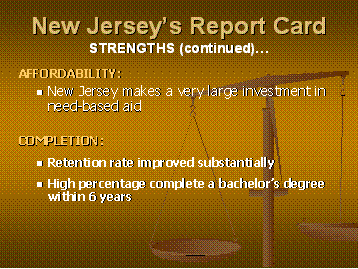
Affordability NJ makes a significant investment in need-based aid. Completion Comparatively, NJ has a very high retention rate from
freshman to sophomore year and has improved substantially. A very high percentage of students complete a bachelor’s
degree within six years.
|
|

Benefits A very high proportion of NJ residents have a bachelor’s
degree, and the percentage has improved significantly
beyond the nationwide increase, despite the large portion
of recent graduates going out-of-state to attend college. So we are fortunate to have strong preparation, a
high participation rate, significant student need-based
aid, comparatively good retention and completion rates,
and a very high educational attainment rate.
|
|
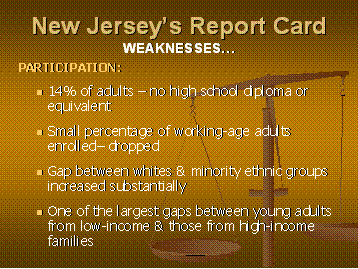
Weaknesses Participation About 14% of adults do not have a high school diploma
or equivalent. A small percentage of working-age adults are enrolled
in higher education, and the percentage has dropped. Staff will look further at this
measure; it appears it may be a place where methodology
may not fit well with particulars of
a state. The gap in college participation between whites and
minority ethnic groups has increased substantially. The gap in college participation between young adults
from low-income and those from high-income families is
one of the largest in the nation.
|
|

Affordability Net college costs for low- and middle-income students
to attend community colleges is nearly 40% of their annual
family income. Net college costs for low- and middle-income students
to attend public four-year colleges is more than half
of their annual family income. Despite the methodology questions on this measure,
net costs have clearly increased.
|
|
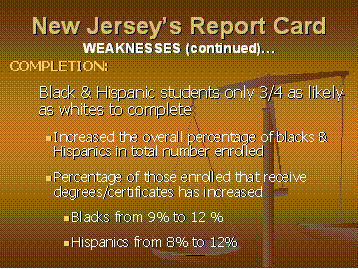
Completion Black and Hispanic students are only three-quarters
as likely as whites to complete certificates and degrees. This is an area where a look beyond the Measuring Up data is important because
NJ has made strides in this area.
- We’ve increased the overall percentage of both
groups in the total number enrolled.
- The percentage of those enrolled that receive
degrees/certificates has increased:
Blacks from 9% to 12% Hispanics from 8% to 12%. That is significant; but in fact, Black and Hispanic
students are still only three-quarters as likely as whites
to complete certificates and degrees.
|
|

In summary In comparison to other states, NJ does very well on
the Measuring Up report. At
the same time, the findings point to areas that clearly
need attention
- The report highlights what we have talked about
and already knew -- we need to close the gap in educational
participation and completion
- Benefits to a college degree are clear – incentives
are there to encourage enrollment – but lack of affordability
remains an obstacle for many
Even in a state like NJ, where marks are among the
best – there are serious areas of concern.
|
|
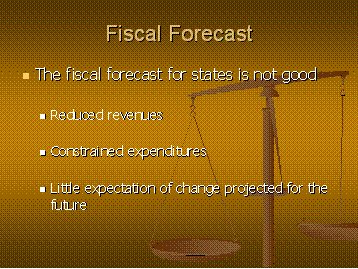
Fiscal Forecast Given the fiscal forecast for the future, we face
a significant challenge. The fiscal picture for states is not good; the long-term
projection is for reduced revenues and constrained expenditures.
And there is little expectation of change for many years
to come.
|
|
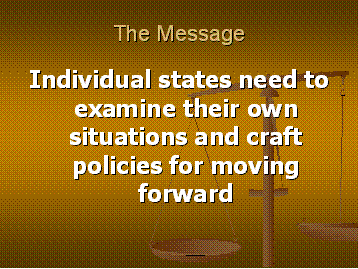
The Message Perhaps the most important message in the report is
that individual states need to examine their own situations
and craft policies for moving forward. This links back to what Chairman Mertz discussed earlier – the
need to initiate a state-level conversation about how
NJ will address its unique challenges and integrate financial
aid and operating support policies for higher education
in the future to meet the needs of individuals and the
state. We look forward to working with HESAA to recommend
a framework to initiate that conversation, which will
include a broad base of key stakeholders. We will look
next month at the possibility of participating in the
national program Chairman Mertz mentioned, which is funded
by the Lumina Foundation to assist states in addressing
the challenges ahead.
|
